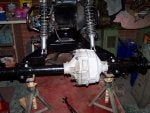imported post
Thanks on the compliment .....:waving:
Ifultimatehandling in the twisties is most important, solid axle with a very rigid swing arm and robust mounting to bike frame at swing arm pivot is the way to go.
If ride smoothness is more important, then independent rear suspension is the way. There is a trade off, but independent suspensioned trikes are more than capable of returning many "smiles per mile".
If you take a trike with rear independent suspension and add a fat anti roll bar (or sway bar as some call it) you are making it act more like a solid axle with rigid swing arm. You gain handling in twisties but loose softness of ride. Champion has an option now that a couple friends have with their new independent Champions, adjustable anti roll bar that is adjusted while you ride.
With a bike you have less unsprung weight and you are always above in relation to your weight on the seat. When healed over in a turn, you still press down into the seat, there is little or no force trying to slide you off the side of the seat.
With a trike, in curves, the forces try to slide you off the seat and you support your upper body.
With a bike, you are mostly traveling within one track, not hard to gently dodge most pot holes, etc. Dips and sways in road surface, roadway super elevation, etc is rarely transmitted to the rider. The ride is smooth.
With a trike, you have three tracks where ever you go, dips and sways and super elevation changes directly affect the trike's attitude, it is harder to get three tracks past a pot hole without one clipping it.
On a bike, you ride straight up through dips, on a trike you move side to side some.
A bike is a smoother ride, but wet surfaces and such can yank the ride out from under you easier.
A trike is not as smooth a ride, but it's a lot more likely to stay under you regardless of surface condition or curve.
With a bike, one must more carefully choose where to pull off the Blue Ridge Parkway for that photo.
With a trike, one has greater lattitude in choices, any near horizontal and some really non horizontal surfaces work fine.
With a bike, you barely move to steer while on a trike, you move your upper body to steer.
With a bike, feet come down at stops, with a trike they stay on the pegs / floor boards.
A bike can't run over your heal, a trike sometimes can if you aren't careful.
A trike takes up more room at a gas pump, don't forget the rear fenders .... some have .... not me ..... not yet.
A bike looses gas mileage when converted to a trike picking up rear sails and weight, but tows a trailer with much less drama as a trike.A trike with large rear brakes will out stop a loaded bike ... and with a trailer, it's no contest. Trike wins, put it in rear of group.
I enjoy both immensly ....for different reasons.
Hope it helps.











